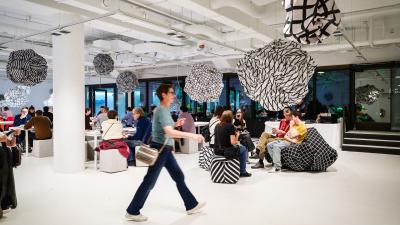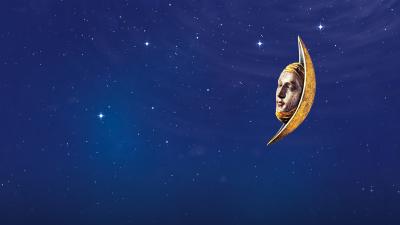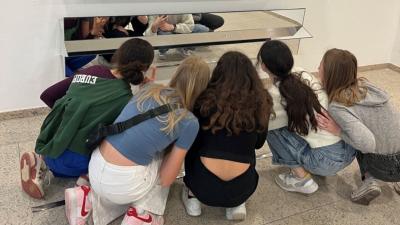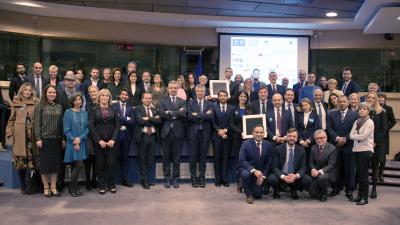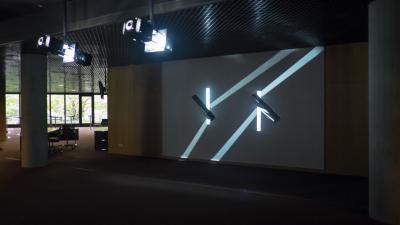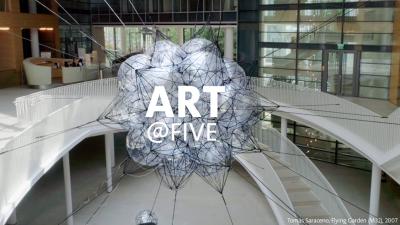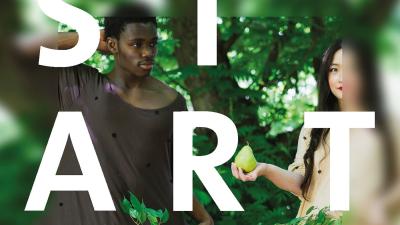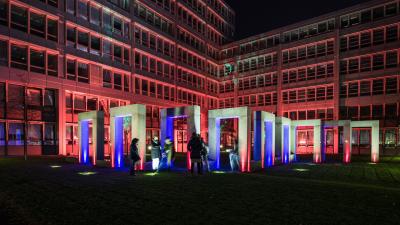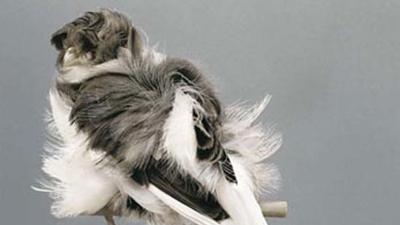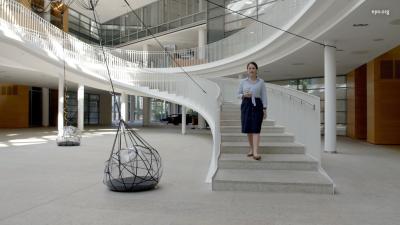Call for Artists: Paper Transformation

Update 18.1.2023
The preselection for the Call for Artists "Paper Transformation has been finished. The jury meetings will take place on 24. January in Munich and on 25. January in The Hague.
The members of the jury selecting the winner in Munich are as follows:
Anna Schneider (Curator, Haus der Kunst, Munich, DE)
Paola Davila (Artist represented in the EPO art collection, MEX)
Luis Berenguer Giménez (EPO Principal Director Communication)
Roberta Romano Götsch (EPO Chief Sustainability Officer)
Kristine Schönert (Curator EPO Art Collection)
Madeleine Schieck (President's Office)
Euridice Pinheiro-Vieira (EPO Patent Examiner in Biotech, Organisation Committee)
Julia Chobanova (EPO Formality Officer, Organisation Committee, degree in art history)
The members of the jury selecting the winner in The Hague are as follows:
Suzanne Swarts (Director of Museum Voorlinden, NL)
Ivan Šuletić (Artist represented in the EPO art collection, RS)
Luis Berenguer Giménez (EPO Principal Director Communication)
Razik Menidjel (EPO Chief Operations Officer)
Kristine Schönert (Curator EPO Art collection)
Madeleine Schieck (President's Office)
Véronique Rogier (EPO Information Technology Department, Organisation Committee)
John Bambridge (CTO Office, Organisation Committee)
Further details will follow after the jury meetings.
To celebrate the 50th anniversary of the signing of the European Patent Convention, the EPO is running a jury competition to commission two paper-based artworks for public display. Inspired by the Office's commitment to sustainability, the EPO invites artists to submit project proposals on the theme of "paper transformation".
The aim is to create two artworks made out of old EPO paper-based patent files, which have recently been replaced with digital versions in the drive towards digital transformation. The content of these paper files includes descriptions of inventions and technical solutions proposed by inventors (see images of the paper files below).
The commissioned artworks will become part of the EPO's permanent art collection. They will be installed inside the entrance halls of the Pschorrhöfe building in Munich and the New Main building in The Hague respectively. With around 500-800 people passing the artworks every working day, they will enjoy high visibility (see images of the building and installation areas below).
By bridging the past and the future, the artworks will represent the EPO's legacy, as well as celebrating innovation and everyone involved in it.
- Participation
-
For the artwork to be placed in Munich, applications are open to professional artists of all nationalities who preferably live and work in Germany.
For the artwork to be placed in The Hague, applications are open to professional artists of all nationalities who preferably live and work in the Netherlands.
For both locations we would expressly like to encourage artists who are at an early stage in their artistic careers to submit proposals.
- Requirements
-
The successful artworks will reflect the following key concepts:
- Sustainability
- Innovation
- (Digital) transformation
- Paper recycling
They will be made primarily out of the paper files provided by the EPO, although additional materials can be added at the artist's discretion. The artworks should also be suitable for display in the entrance hall of the EPO offices in Munich and in The Hague respectively;
- Award
-
The two artists selected will each receive EUR 45 000 (Net) to produce the commissioned artworks. This amount must cover the artist's fee, production and travel costs. The EPO will only be responsible for providing the requested amount of paper files for the artwork and a workspace for the artist to complete the project onsite. The delivery of the artwork to the respective EPO premises is the sole responsibility of the artist. The artwork also needs to be professionally prepared for exhibition.
The EPO will pay 20% of the award when the agreement is signed; 20% at the project mid-point; and 60% on its completion.
- How to apply
-
Applications must be submitted online and in English. Applicants need to submit:
- Cover letter CV with explicitly stated place of residence and contact details
- Summary of their artistic career
- Link to a portfolio showing examples of their work
- Short narrative description of the project concept, together with any sketches or 3D models of the concept and the estimated paper volume required
All components of the proposal must be submitted in digital format to callforartists@epo.org by midnight on 23.10.2022.
For more information on how to submit any physical models (3D), you can contact us at the email above. Applications that are incomplete or submitted after the deadline will not be considered. There is no submission fee and artists may submit more than one concept proposal. The personal data that you share with us in the context of this competition will be processed according to the following
- Selection procedure
-
- Preselection: By an art advisory group made up of EPO employees. The finalists will be asked to submit a full-colour detailed concept description for consideration by the jury. This should include a two-minute video describing the ideas and inspiration behind their proposal. A combined EUR 1 500 lump sum (net) for the detailed concept description and travel expenses will be paid to the selected candidates.
- Final decision: The final decision will be taken by a jury consisting of museum directors, curators, artists represented at the EPO art collection and EPO employees.
External jury members:
- Anna Schneider (DE) - Curator, Haus der Kunst, Munich, Germany
- Ivan Šuletić (RS) - Artist
- Paola Davila (MEX) - Artist
- Suzanne Swarts (NL) - Director Museum Voorlinden, Wassenaar, Netherlands
- Selection criteria
-
- Artistic excellence, vibrancy, and originality of the artist
- Successful and convincing implementation of key aspects outlined in the concept
- Appropriateness of the concept for the specific site in the entrance hall of the EPO building Pschorrhöfe in Munich and the New Main building in The Hague respectively
- Timeline
-
- October 2022 – Evaluation of the submitted proposals
- November 2022 – Notification of pre-selected artists
- November 2022 – Site tour offered to finalists
- February 2023 – Public announcement of the selected artist
- August 2023 – Completion of the artwork
- September 2023 – Expected installation
- October 2023 – Premiere of the artwork and the movie
- Policies
-
Any proposed concepts and/or detailed designs will remain the property of the artist unless the design is selected by the EPO. The accepted artists will be part of our permanent art exhibition.
The selected detailed concept description and artwork will be the property of the EPO. As such, no royalties, or fees, beyond the initial artist's fee, will be paid for its ongoing use by the EPO.
A recording of the different phases of the realisation process including interviews with the artists (video, e.g., timelapse) will be created and made available to selected audiences during and after the installation of the artworks.
As a part of the award, the EPO will also have the right to reuse the final designs to make miniature 3D printed versions of the art object that can be used as souvenirs for staff and other visitors.Any unapproved substitutions or deviations from the approved final designs or proposed materials may result in termination of the contract, removal of imagery, and non-payment of any amount due.
The jury's final decision on the winners is at its sole discretion and shall be binding on all participants. It shall not be subject to appeal.
- Art collection
- The EPO has an extensive art collection that comprises around 1 000 works, including 40 site-specific commissions. Artists from most of the 38 EPO member states are represented, reflecting the diversity and richness of contemporary culture. An impression of the collection can be found at the Art Collection.
- Background
-
The European Patent Office (EPO) examines European patent applications, enabling inventors, researchers and companies worldwide to obtain protection for their inventions in up to 44 countries with a single patent application. The European Patent Office (EPO) was set up in 1973. From 16 signatory states of the European Patent Convention in 1973, the Organisation has now grown to 38 member states, including all 27 EU member states plus countries such as Norway, Switzerland and Türkiye.
As the patent office for Europe, we are proud to deliver high-quality patents and efficient services that foster innovation, competitiveness, and economic growth. Our work will contribute to a safer, smarter, and more sustainable world.
- Contact
-
For further inquiries about the competition please contact: callforartists@epo.org
- Annex I – EPO paper files
-
The average weight of a paper file is 1.3 kg and its average thickness is 3 cm. In the current EPO archives, an average of about 53 files are stored on a Zippel bar of 1.6 m.
The standard EPO paper file folder has the following characteristics:
Format: 330x280mm
Design: Pockets front and back, sealed with linen gussets; two middle clampsT-glide element:
Zippel T-glide system
Sheet iron, nickel- and chrome-plated
0,5 mm thick, fixed at six points on either sideT-Glide folders have built-in hooks allowing them to hang on a rail. This filing system currently used in the EPO file store makes it easy to archive and retrieve files.
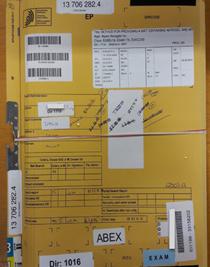
1. Cover of a typical EPO paper file
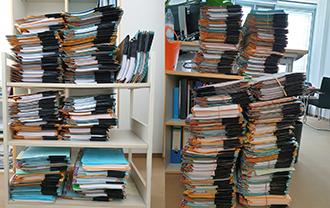
2. Piled EPO paper files
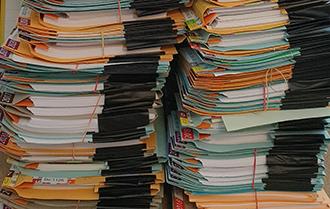
3. Stacked EPO paper files
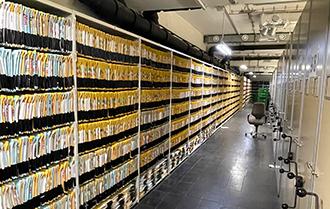
4. The EPO filestore
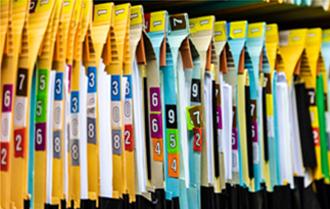
5. Hanging EPO paper files
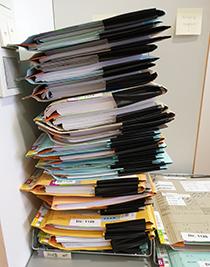
6. Stacked EPO paper files
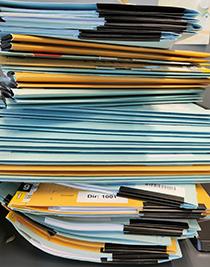
7. Stacked EPO paper files (different colours)
- Annex II – Buildings and installation areas
-
Munich, Pschorhöfe Building
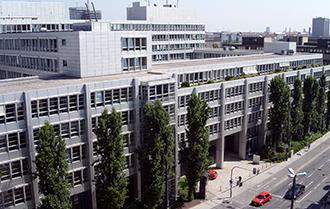
1. The PschorrHöfe buildings of the EPO
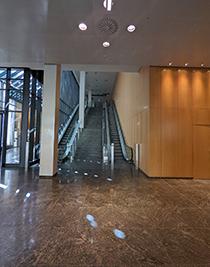
2. The entrance hall of the Pschorrhofe main building
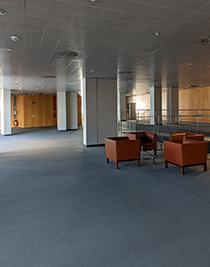
3. The upper level of the entrance hall of the PschorrHöfe main building, where the artwork will be placed
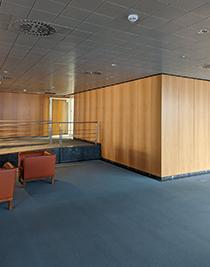
4. The upper level of the entrance hall of the PschorrHöfe main building, where the artwork will be placed
The Hague, the new main building in Rijswijk designed by Ateliers Jean Nouvel and Dam & Partners Architecten
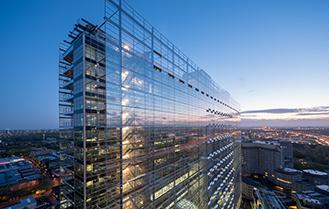
1. The European Patent Office in Rijswijk designed by Ateliers Jean Nouvel and Dam & Partners Architecten
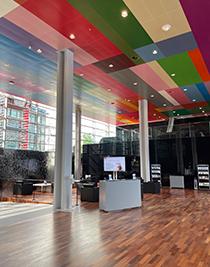
2. The entrance hall of the EPO New main building in Rijswijk
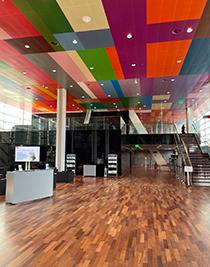
3. The entrance hall of the EPO New main building in Rijswijk
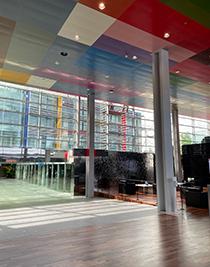
4. The entrance hall of the EPO New main building in Rijswijk
- Annex III – Art collection
- See an in-depth overview of the EPO Art Collection.
FAQ
- Are high-resolution photos available of the locations chosen for the installations?
-
Further high-resolution photos of the chosen locations are available here:
Munich PschorrHöfe (ZIP, 80 MB)
The Hague New Main (ZIP, 18 MB) (depending on the final artwork, three locations may be suitable)
- Are more detailed plans available for the chosen location in Munich?
-
Download further photos (ZIP, 9 MB)
- Is it mandatory to reuse one or more old EPO paper files when creating the proposed art object?
-
Yes. The proposal must be based on the reuse/recycling/recapture of one or more old EPO paper files.
- What form can the art object take?
-
Each artist is free to choose their preferred medium for their submissions, as long as the proposal transforms our paper files into a work of art.
- Why is the Call for Artists open preferably to artists who live and work in the Netherlands or Germany?
-
In support of the EPO’s commitment to community outreach, to minimise travel costs and to avoid excessive transport costs for delivering the final objects, the Call for Artists has been structured around searching for artists who preferably have a connection with the country where the art objects will be installed.
- Are current EPO staff members eligible to apply for the Call for Artists?
-
No. The Call for Artists is for professional artists and is not open to current EPO staff members.
- Can artists of all ages apply to enter the competition?
-
Yes, but artists at the start of their artistic career are particularly encouraged to apply.
- How can I submit the physical model that I have made to help explain my concept?
-
In addition to the email submission, any physical models, clearly labelled as a “Call for Artists” submission, can be sent by post or courier to:
Room 3523
PschorrHöfe 1-4
European Patent Office
Bayerstraße 34
80335 München
DeutschlandOr
Room S03N43
Shell Building
European Patent Office
Patentlaan 2
2288 EE Rijswijk
The NetherlandsA photo of the object should be included in the email submission with a note that the physical model has been sent by post. If possible, a tracking number should be included in the email submission.
- What format should I use in my submission of any 3D models?
-
Any digital 3D models should be submitted in USDZ, OBJ or GLTF format.
- How should the 3D models be submitted?
-
Any digital 3D models should be submitted as attachments to the email containing the other components of the submission.
- Are there any limitations in terms of fire safety regulations and classifications?
-
No, there are no limitations in terms of fire safety regulations and classifications. The exhibition areas are provided with sprinklers and smoke detectors and there are no emergency escape routes passing nearby.
- What is the paper thickness of the inner sheets of a paper file in grams?
-
We print all file content on standard A4 paper (white or sometimes green). The standard is 80 g per m². Only very occasionally do we include other types of paper from different sources. On rare occasions, the files include photos that have been submitted as models. Each file also includes one A4 label sheet with the unused labels in the front left pocket. Older files might also include one or two additional cardboard folders. We do not know the cardboard weight of the cover and the additional folders.
- What is the average size of an average scanned paper file?
-
The average paper file has 110 pages. Each page is around 41 kB as a scanned image. This makes a total of 4.5 MB in scanned images for an average paper file.
- What kind of wood is the cladding of the exhibition area in Munich made of?
-
The cladding of the exhibition area in Munich is made of steamed beech.
- What type of ceiling does the exhibition area in Munich have?
-
The ceiling is a suspended metal ceiling.
- What type of material has been used to cover the floor of the exhibition area in Munich?
-
The floor is covered with carpet.
- Is it possible to obtain samples of the paper files?
-
For the first part of the call for artists we do not provide any paper files. At this stage the focus will be on the idea and its technical/creative details. The selected proposals can be further developed in the second part of the call where samples of the paper files will be made available.
- Can I apply to enter the competition in collaboration with another artist?
-
Yes. Joint entries are permitted.
- Are all European countries represented in the database and is it possible to state the percentage?
-
Yes. All EPO member states are represented in the database. You can find the exact percentage and further details here:
- Is it possible to visit the building in Munich or in The Hague?
-
No, this is not possible at this stage of the competition.
- Is a digital 3D model in one of the formats USDZ, OBJ or GLTF absolutely necessary or can I as an artist also send you an illustration of my proposal as a Photoshop animation?
-
No, it is not necessary to submit a digital 3D model. An illustration of your proposal and/or submission of a physical model will be fully sufficient.
- Is the audience allowed to read the content of the documents I will use for my installation
-
The audience is allowed to see the public part of the file such as the description of the technical invention, the claims and the drawings. Any parts of the paper files containing personal information or personal annotations should not be used in a readable manner.
- What should the cover letter contain?
-
A cover letter should state your intention to apply to the Call for Artists and how your artistic profile matches our requirements.
- Could the sculpture also involve an ongoing transformation process?
-
Yes. Artists are free to choose their preferred medium for their submissions as long as the proposal transforms our paper files into a work of art.
- Are there any restrictions related to water, electricity, light or sound for the installation?
-
Preferably no water. If electrical power is needed, please be aware that an invisible outlet in the ground floor / ceiling is not possible.
- Will I be able to choose specific files?
-
No. You cannot choose specific paper files. If you need inspiration concerning certain inventions, please take a look at our patent search machine (link below) where you can find all types of inventions.
- What is the height of the entrance hall of the building in The Hague?
-
The entrance hall in The Hague is 6.92 m high. There should be 0.5 m space left between the top of the artwork and the ceiling.
- What does a paper file look like inside? Can I have some images of the content of the paper files?
-
Currently there are no images in the FAQ showing the inside of a file. Nevertheless, you can view the digital files in our public database:
Espacenet: patent database with over 120 million documentsYou can try an easy example by searching for a pizza cutter.
- What is the maximum weight of the artwork?
-
Currently we do not have any weight restrictions. We advise you to submit your concept, which can be adapted in the second round of the competition if need be.
